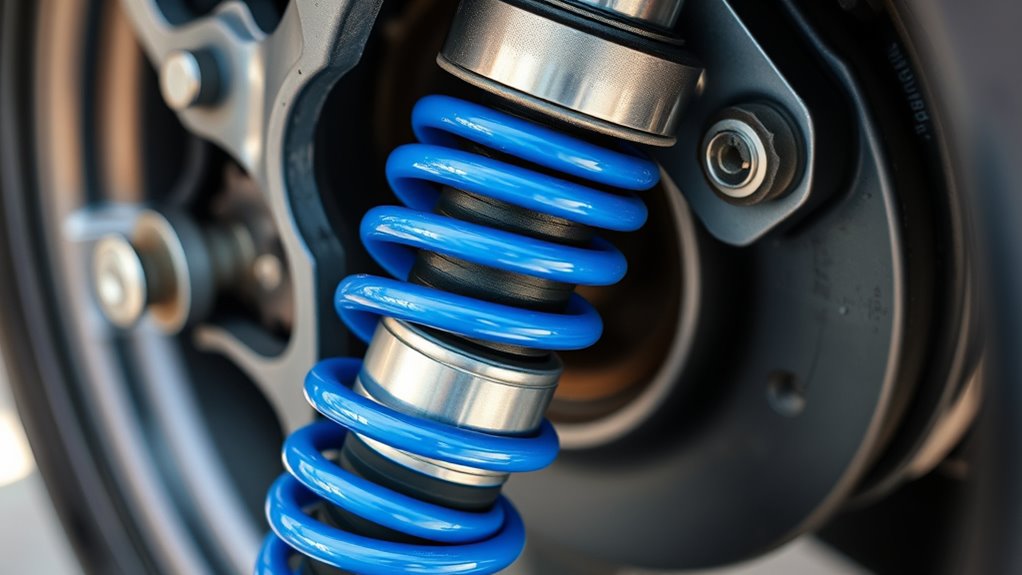Your suspension system, including shocks and struts, absorbs bumps, keeps your vehicle stable, and guarantees a smooth ride. Regular checks help catch wear early—look out for noises, uneven tire wear, or excessive bouncing. Replacing worn components restores handling and safety, while upgrades can improve comfort and performance. Proper maintenance prolongs your suspension’s life and saves money. Keep these basics in mind to keep your vehicle running smoothly, and discover how to keep everything in top shape.
Key Takeaways
- Shocks and struts absorb impacts and improve ride comfort, handling, and vehicle stability.
- Regular inspection and replacement of worn shocks and struts prevent uneven tire wear and unsafe driving conditions.
- Proper wheel alignment ensures even tire contact, reduces suspension stress, and enhances safety.
- Upgrading suspension components can optimize performance for different terrains and driving styles.
- Signs of suspension issues include knocking noises, excessive bouncing, uneven tire wear, and steering problems.

Your car’s suspension system is essential for a smooth, safe ride by absorbing shocks and maintaining control on the road. When your suspension isn’t functioning properly, you might notice uneven tire wear, poor handling, or a bumpy ride. One of the first steps to ensure your suspension performs optimally is to keep your wheel alignment in check. Proper wheel alignment ensures your tires contact the road evenly, reducing unnecessary stress on suspension components and improving fuel efficiency. If your wheels are misaligned, you might experience pulling to one side or a crooked steering wheel, which can accelerate suspension wear. Regularly checking and correcting your wheel alignment is a simple yet effective way to extend the lifespan of your suspension system and improve driving comfort. Understanding the refrigeration cycle can also help you recognize how different suspension components work together to absorb shocks and vibrations.
Suspension upgrades can also make a significant difference, especially if you’re looking to enhance your vehicle’s performance or comfort. Upgrading shocks and struts allows you to customize how your car handles different terrains and driving styles. For example, high-performance shocks can give you better stability during aggressive driving or cornering, while more comfortable shocks can smooth out rough roads. When considering suspension upgrades, it’s vital to choose components that match your driving needs and vehicle specifications. Upgraded suspension parts can help absorb larger shocks, reduce body roll, and improve overall handling, making your driving experience safer and more enjoyable.
Maintaining your suspension involves more than just upgrades and alignments. Regular inspections are crucial to catch issues early. Look out for signs like knocking noises, excessive bouncing, or uneven tire wear, all of which can indicate suspension problems. Shocks and struts are particularly prone to wear over time, especially if you frequently drive on rough roads or carry heavy loads. Replacing worn shocks and struts restores ride quality and handling, preventing further damage to other suspension parts. Additionally, keeping your suspension components properly lubricated and tightened helps prevent premature failure.
Frequently Asked Questions
How Often Should Suspension Components Be Inspected?
You should inspect your suspension components at least once a year or every 12,000 miles, whichever comes first. During inspections, check for signs of wear, vehicle alignment issues, and guarantee suspension lubrication is adequate. Regular inspections help catch problems early, improve ride quality, and extend component life. If you notice uneven tire wear or handling issues, get your suspension checked sooner to maintain safety and ideal vehicle performance.
Can I Replace Shocks and Struts Myself?
Thinking of tackling DIY repairs on shocks and struts? Sure, why not turn your garage into a suspension tool playground! Just remember, replacing these components requires some serious skills and the right tools. If you’re confident with your wrench-wielding prowess, go ahead. But if you’re new to suspension work, you might end up more shaken than your ride. Sometimes, leaving it to pros saves you from a bumpy, expensive mistake.
What Are Signs of Worn Suspension Parts?
You’ll notice worn suspension parts if you experience alignment issues or uneven tire wear. When suspension components weaken, your car may pull to one side or feel unstable during turns. Uneven tire wear is a key indicator, signaling that your suspension isn’t keeping the tires properly aligned. If you spot these signs, it’s time to get your suspension inspected so you can address any worn parts before they cause further problems.
How Does Suspension Affect Vehicle Handling?
Think of your vehicle’s suspension as the conductor of a symphony, guiding smooth handling. When suspension is in good shape, your car responds precisely to steering, maintains proper wheel alignment, and minimizes uneven tire wear. Worn parts can turn this harmony into chaos, causing pulling, vibrations, and poor control. So, maintaining your suspension healthy ensures your drive stays balanced, safe, and enjoyable, like a well-conducted orchestra.
Are Aftermarket Suspension Upgrades Worth It?
You might find aftermarket suspension upgrades worth it if you’re seeking performance enhancements, like better handling or a smoother ride. They can substantially improve your driving experience, but consider the cost considerations involved. These upgrades often come with higher prices and potential maintenance needs. Weigh the benefits against the costs to decide if the performance boost aligns with your driving goals and budget.
Conclusion
Now that you know the ins and outs of shocks, struts, and maintenance, you’re better equipped to keep your ride smooth and safe. Think of your suspension system as the heartbeat of your car—it keeps everything balanced and on track. Regular checks might seem small, but they’re the secret to a comfortable drive and avoiding costly repairs down the road. So, give your suspension the love it deserves; your car—and your nerves—will thank you.









